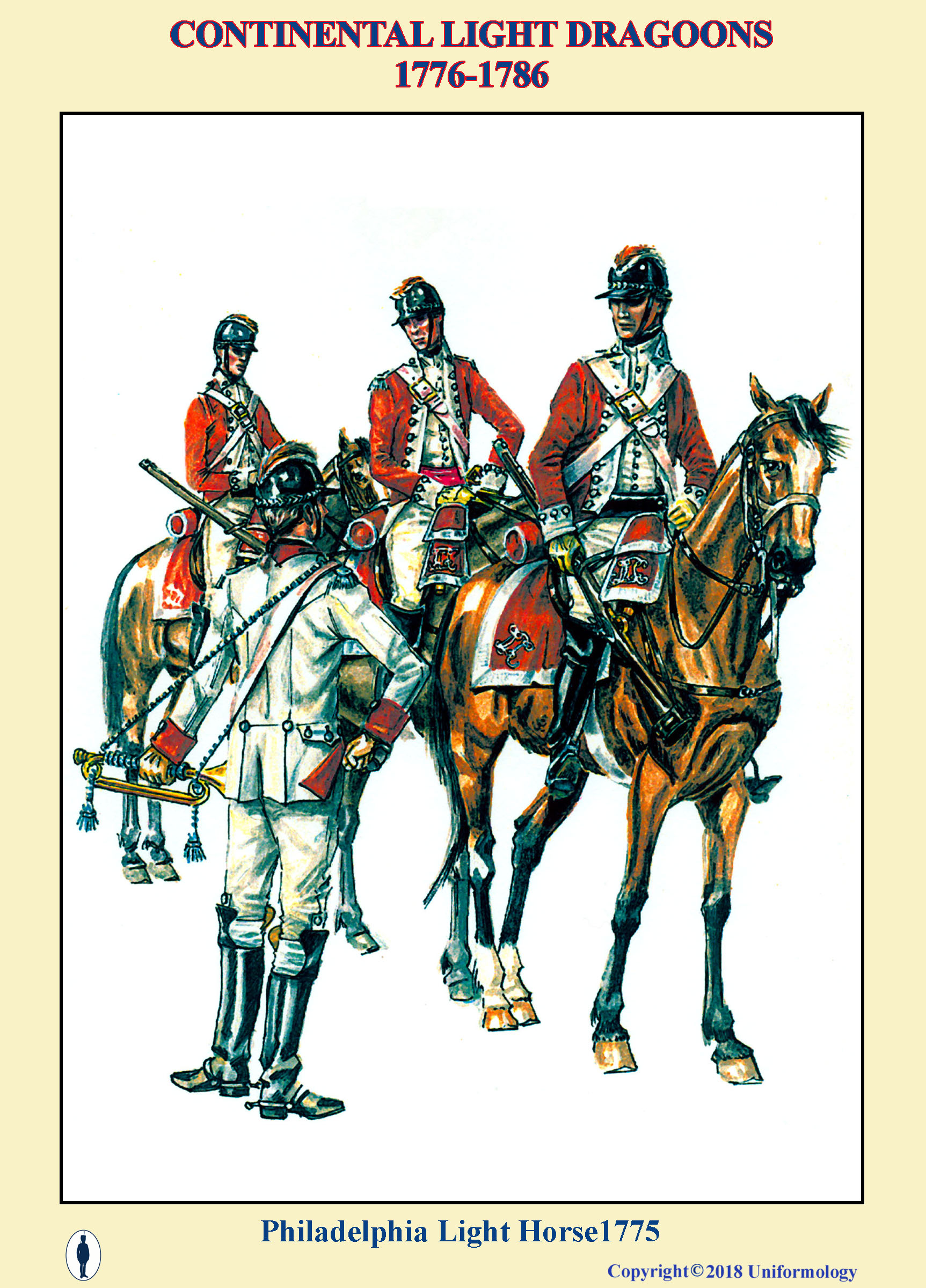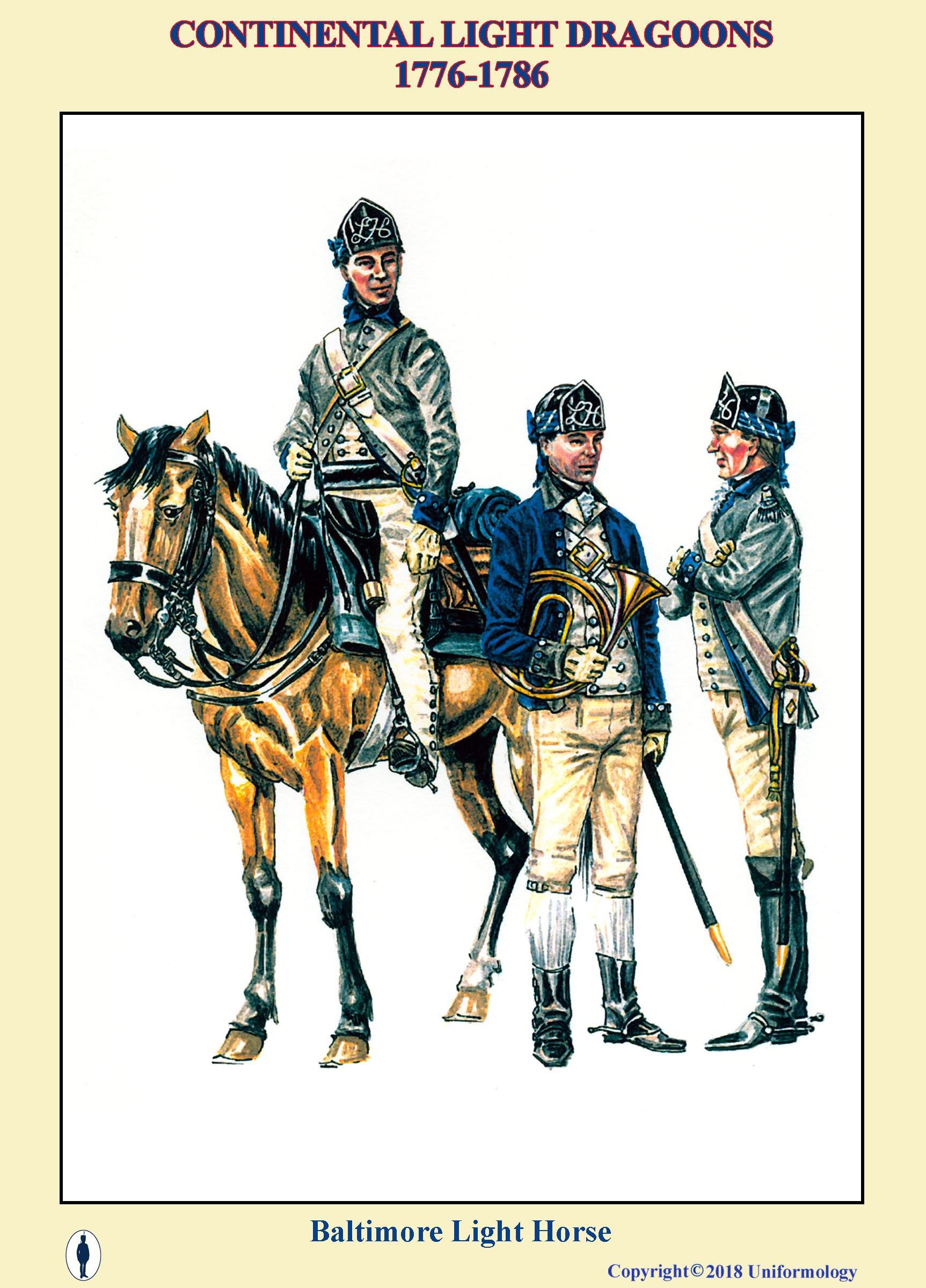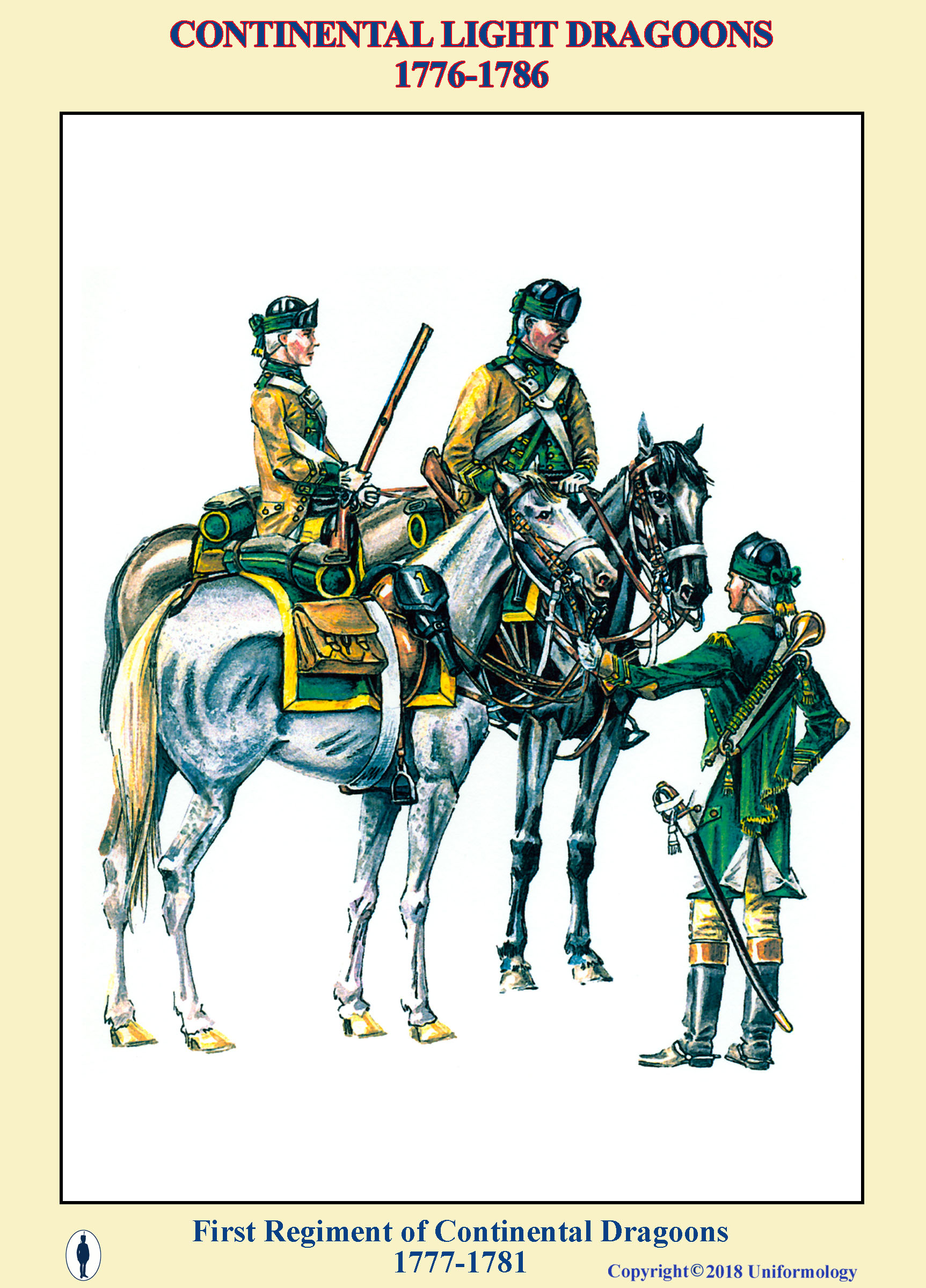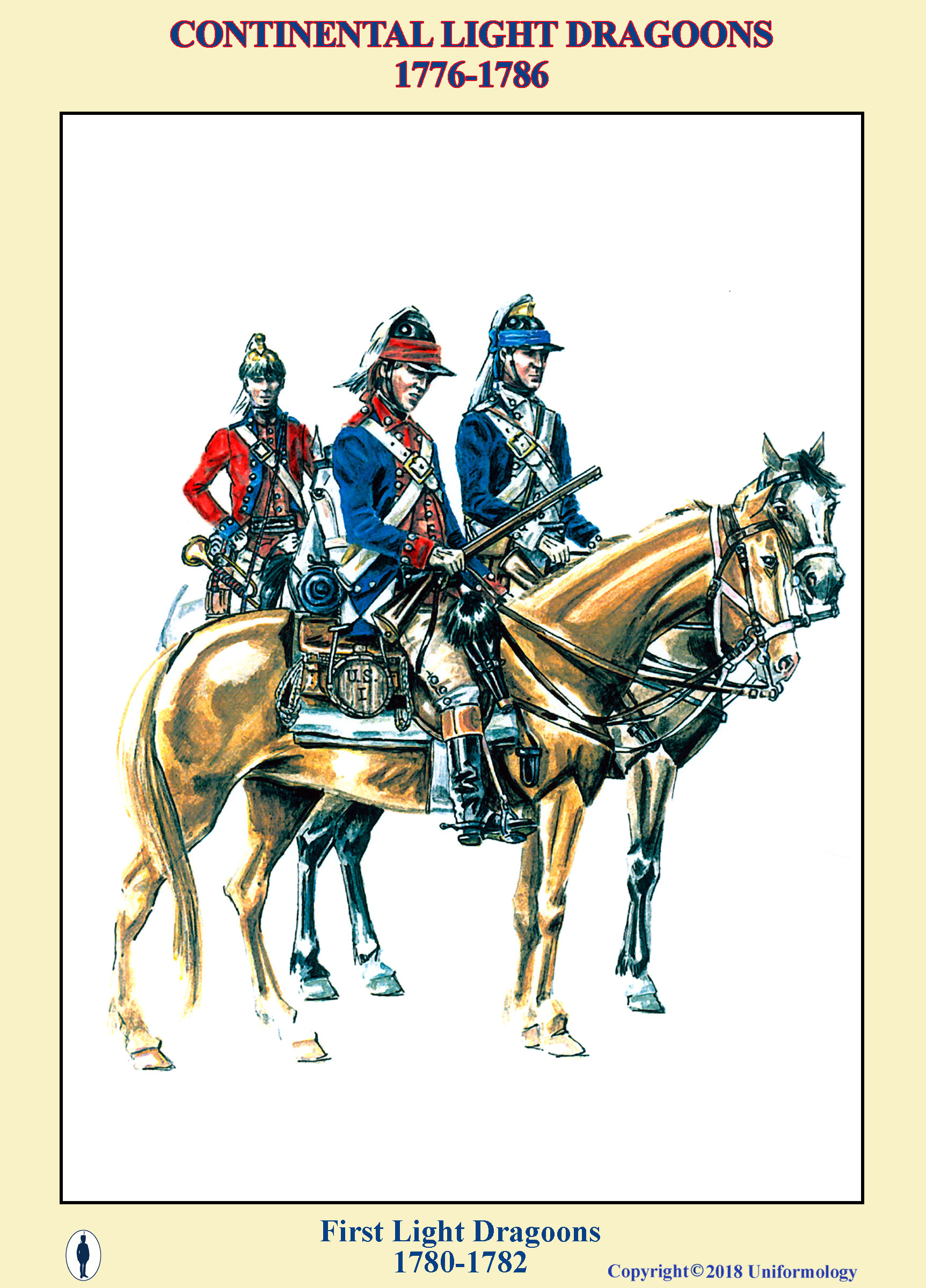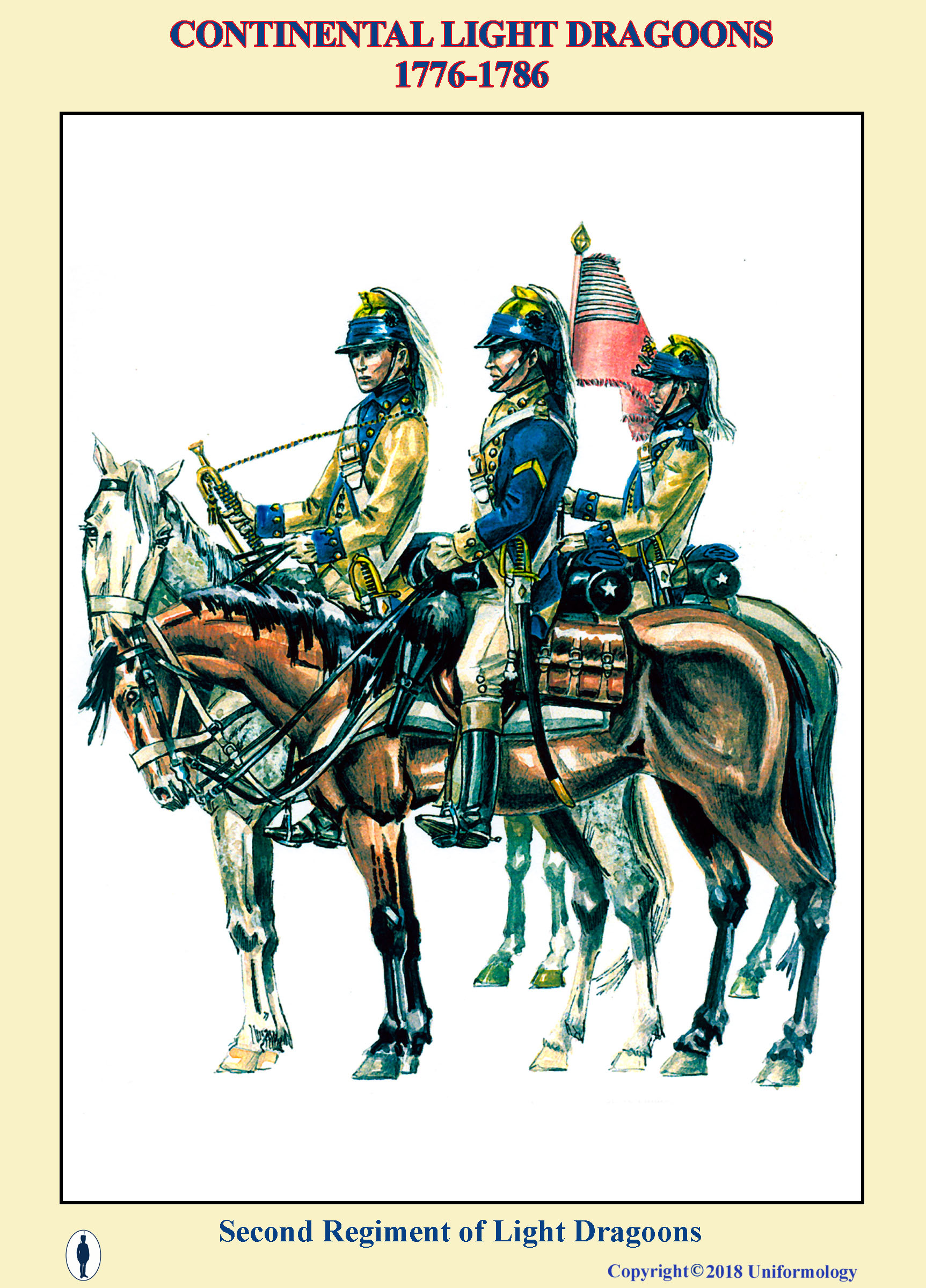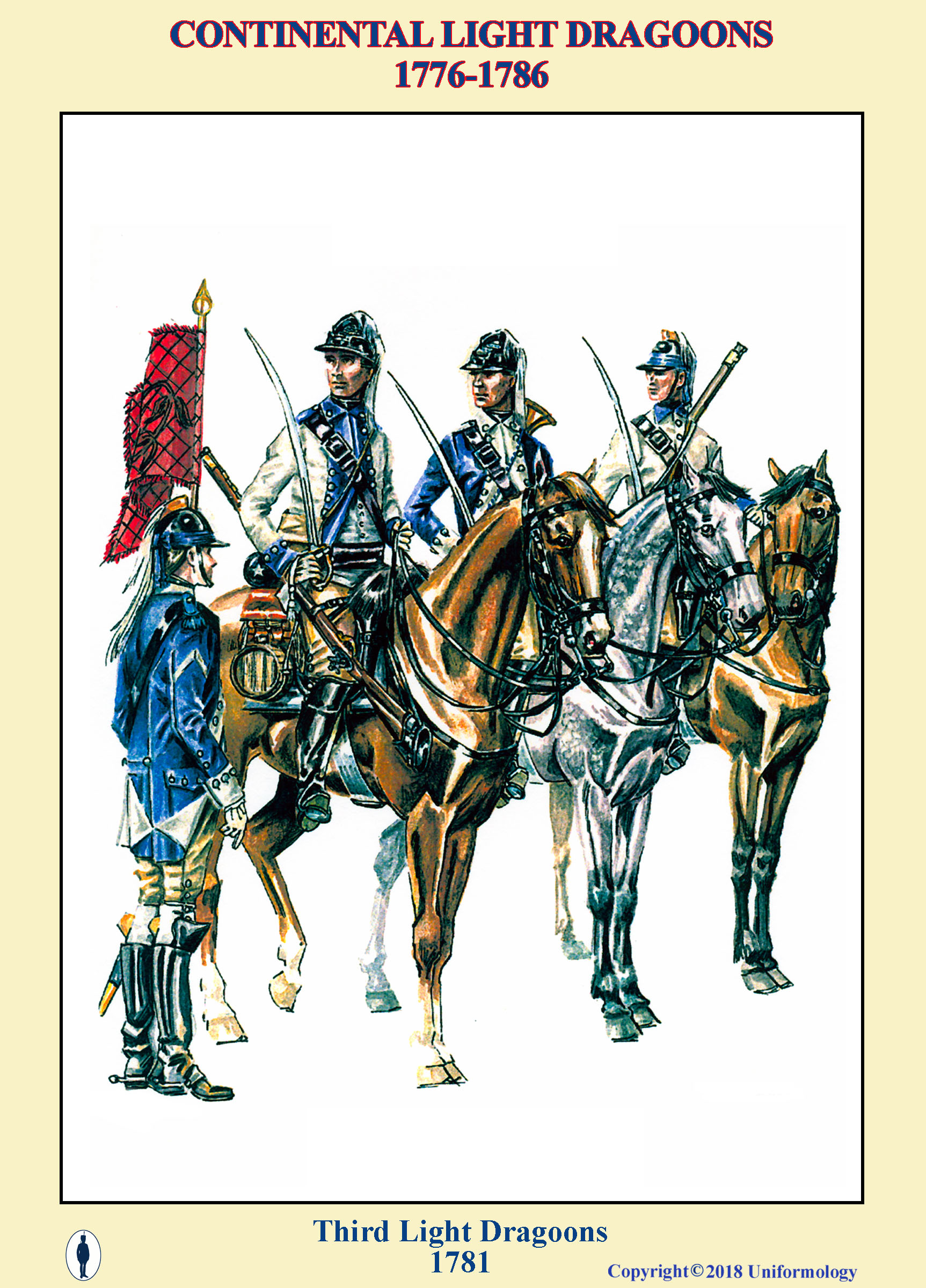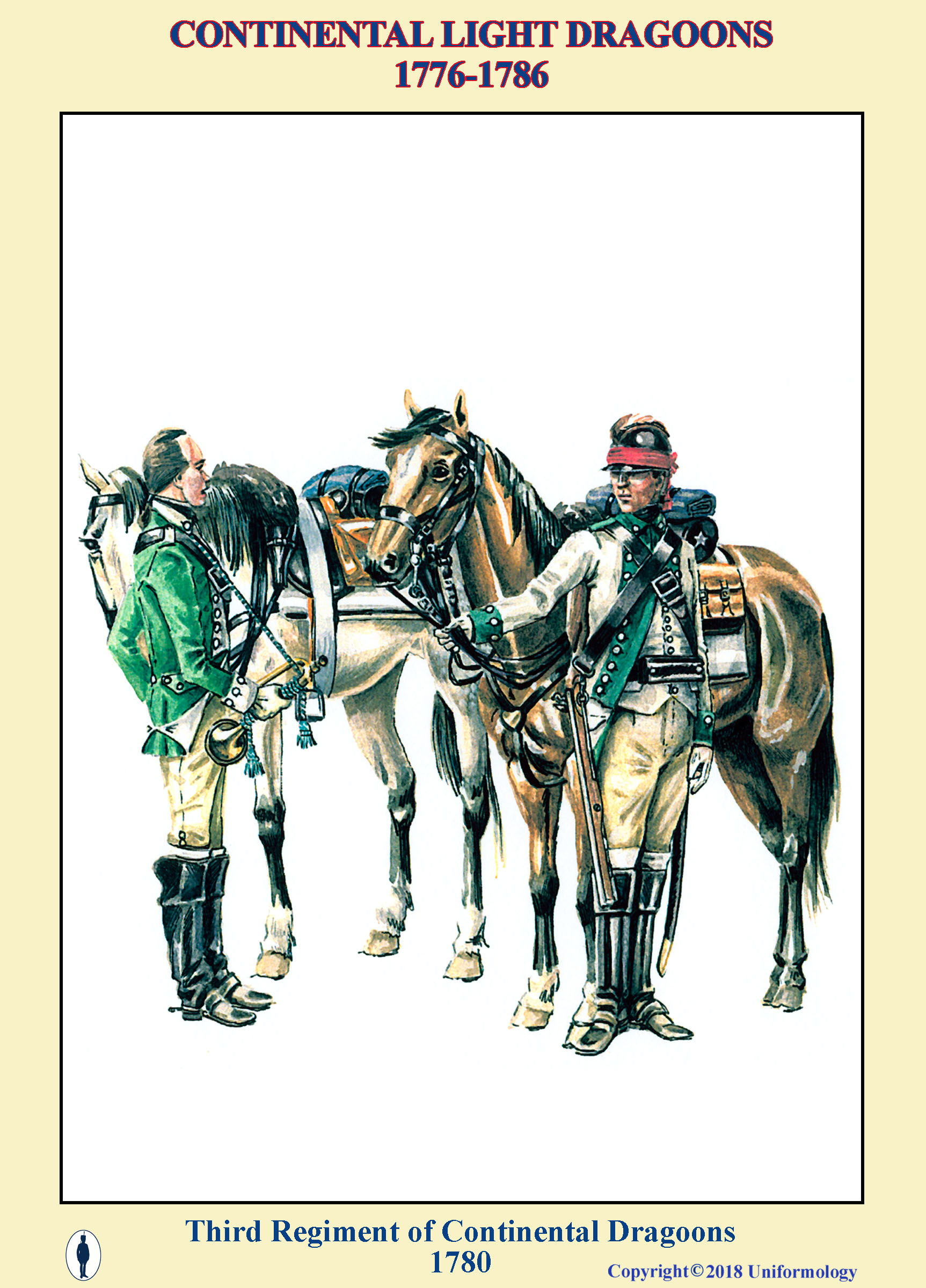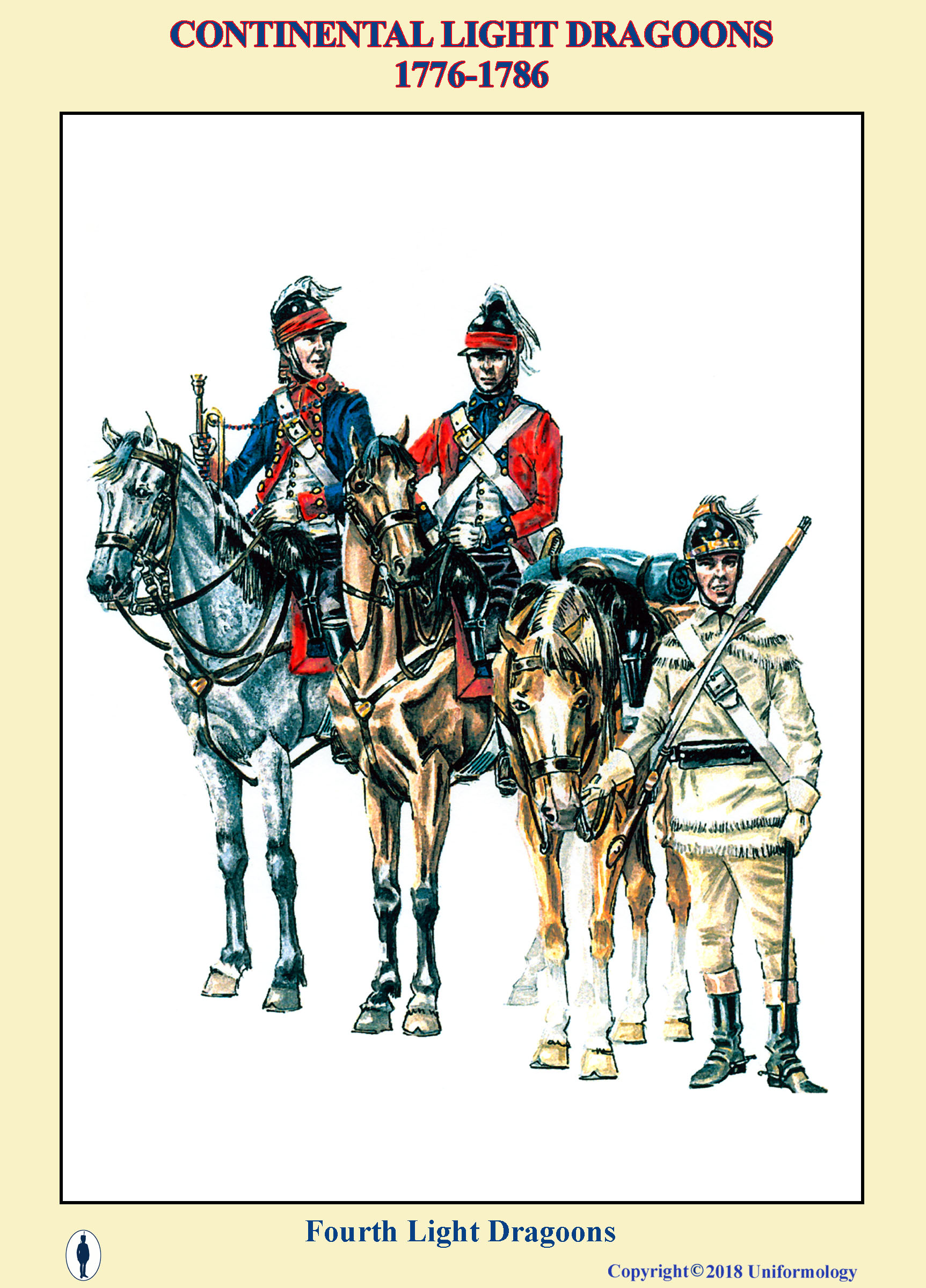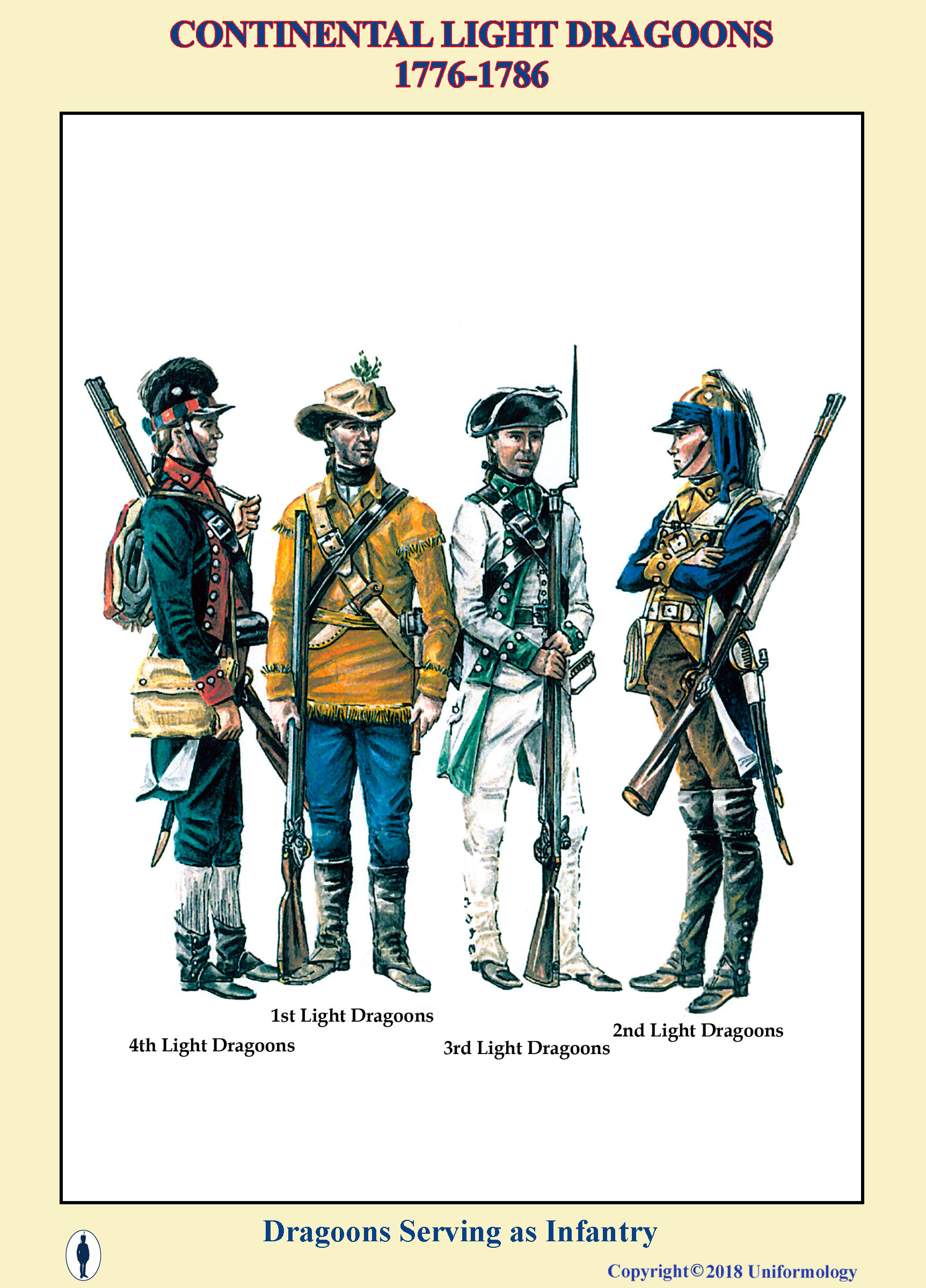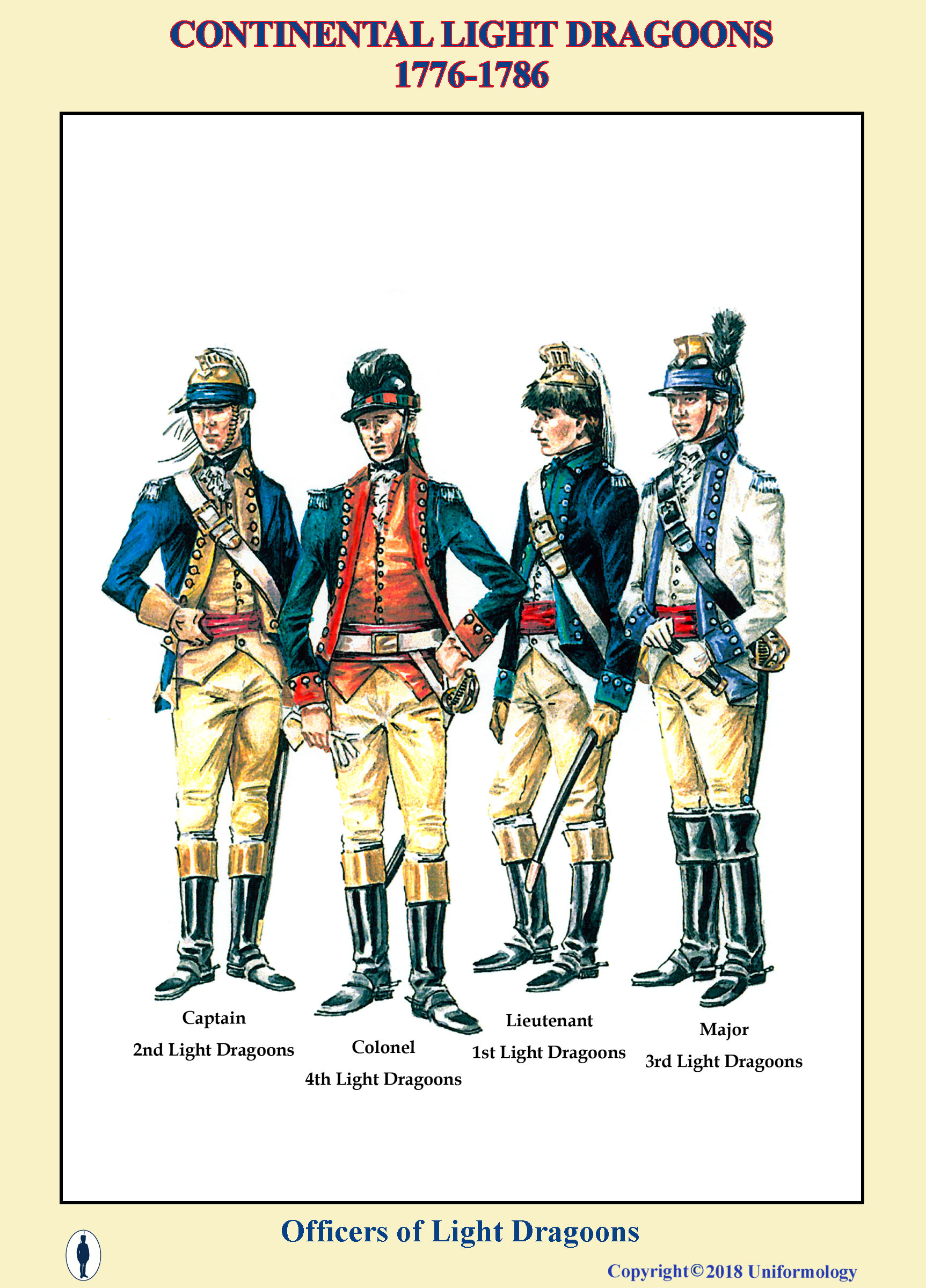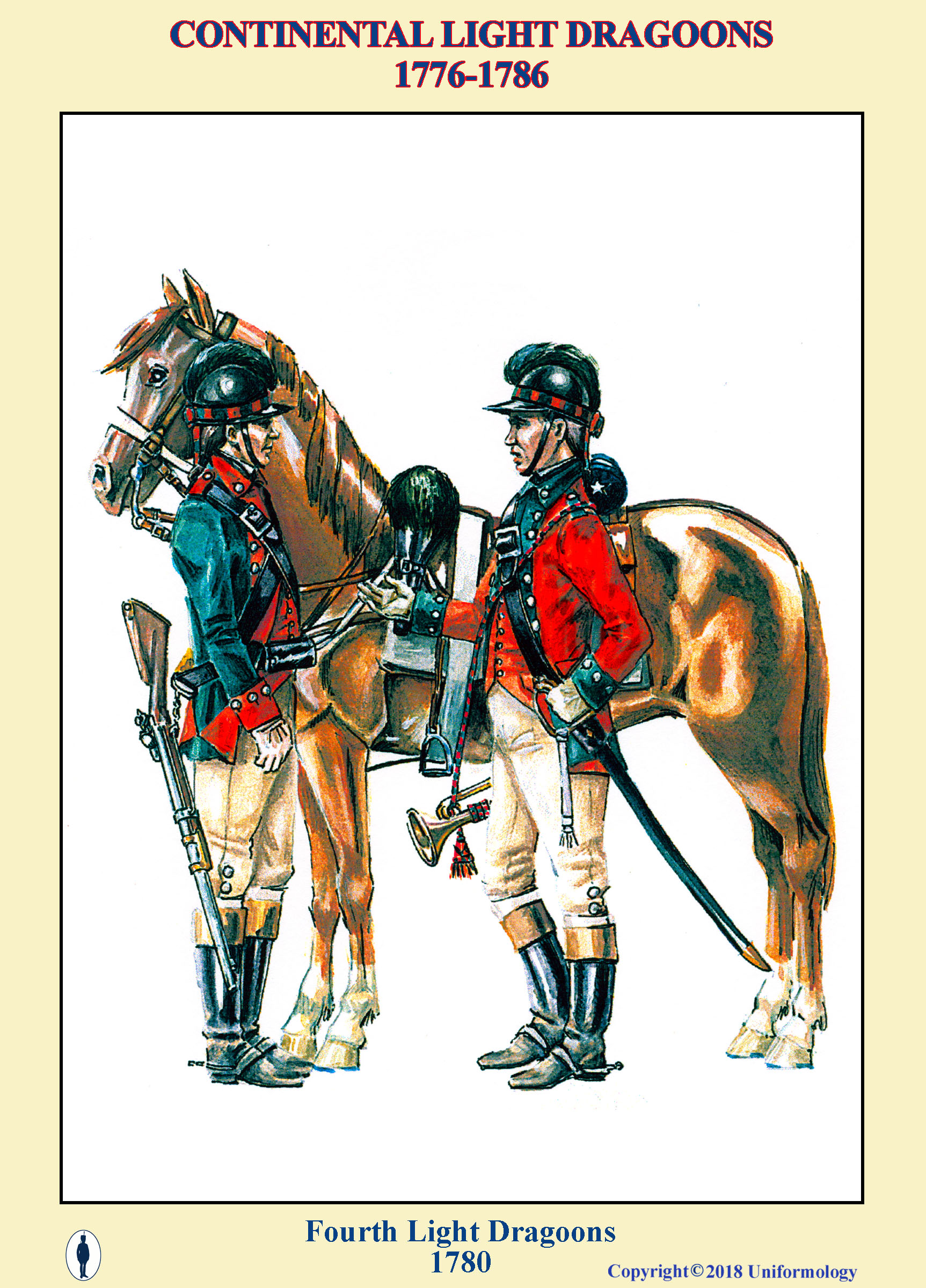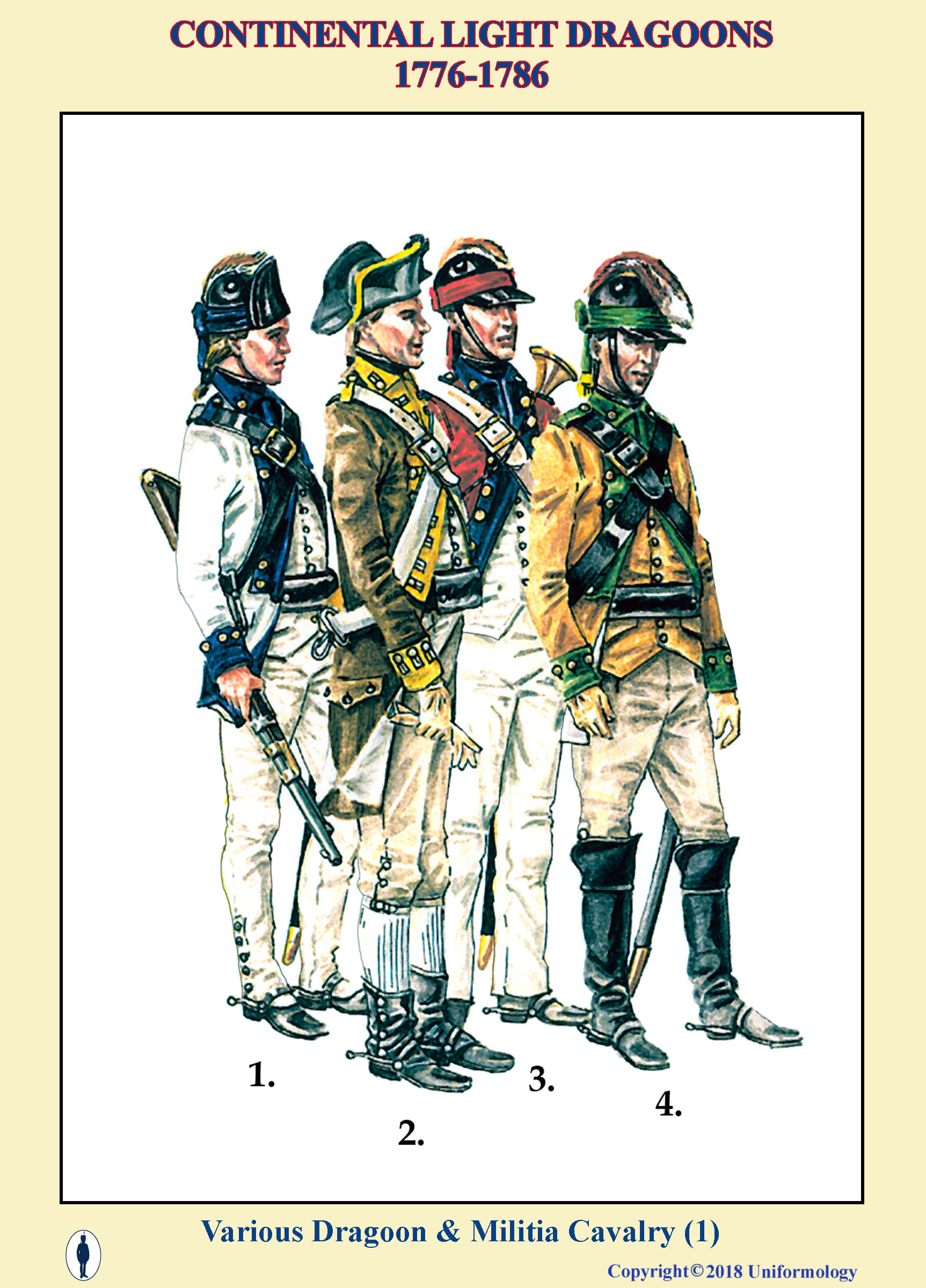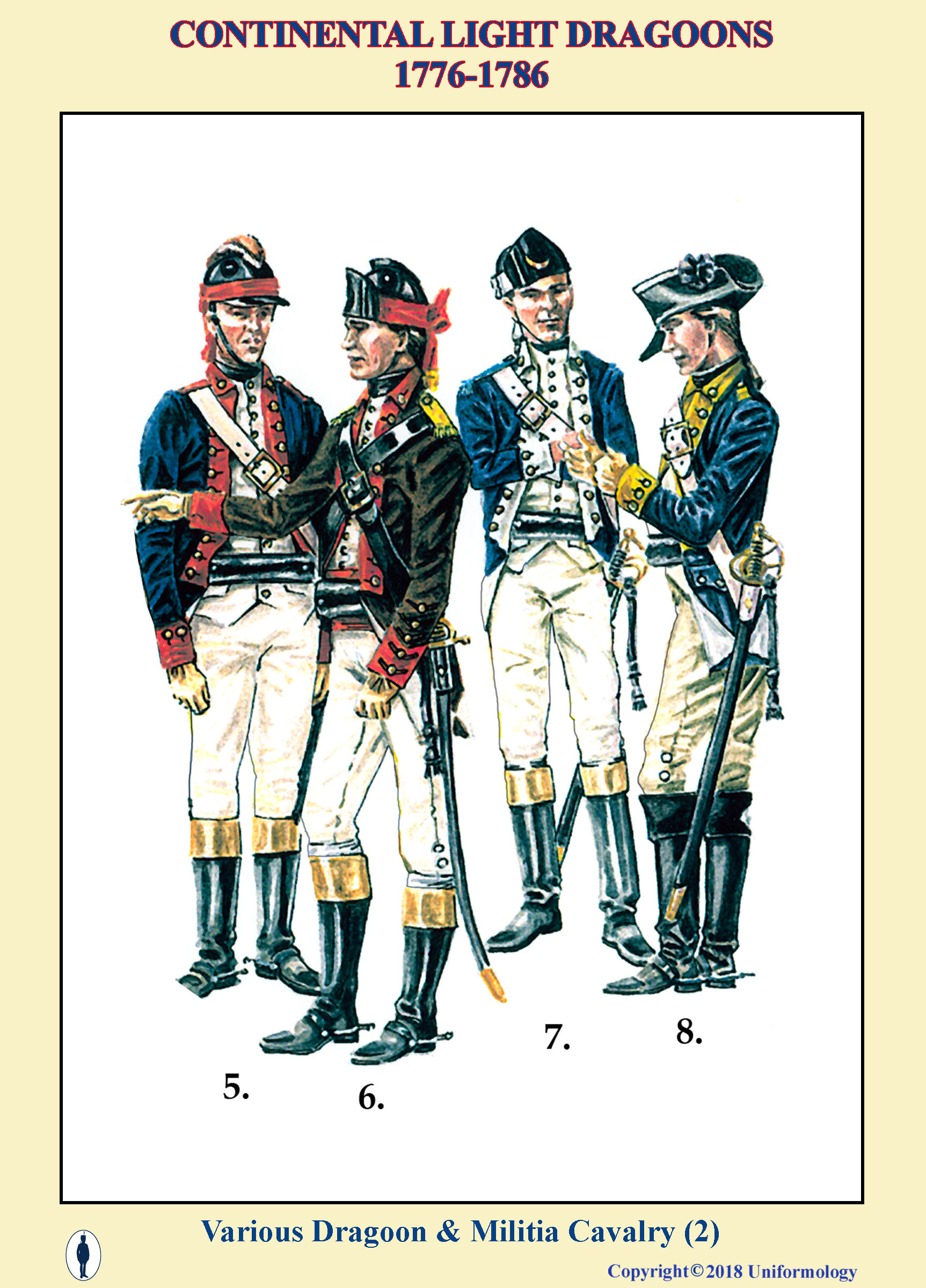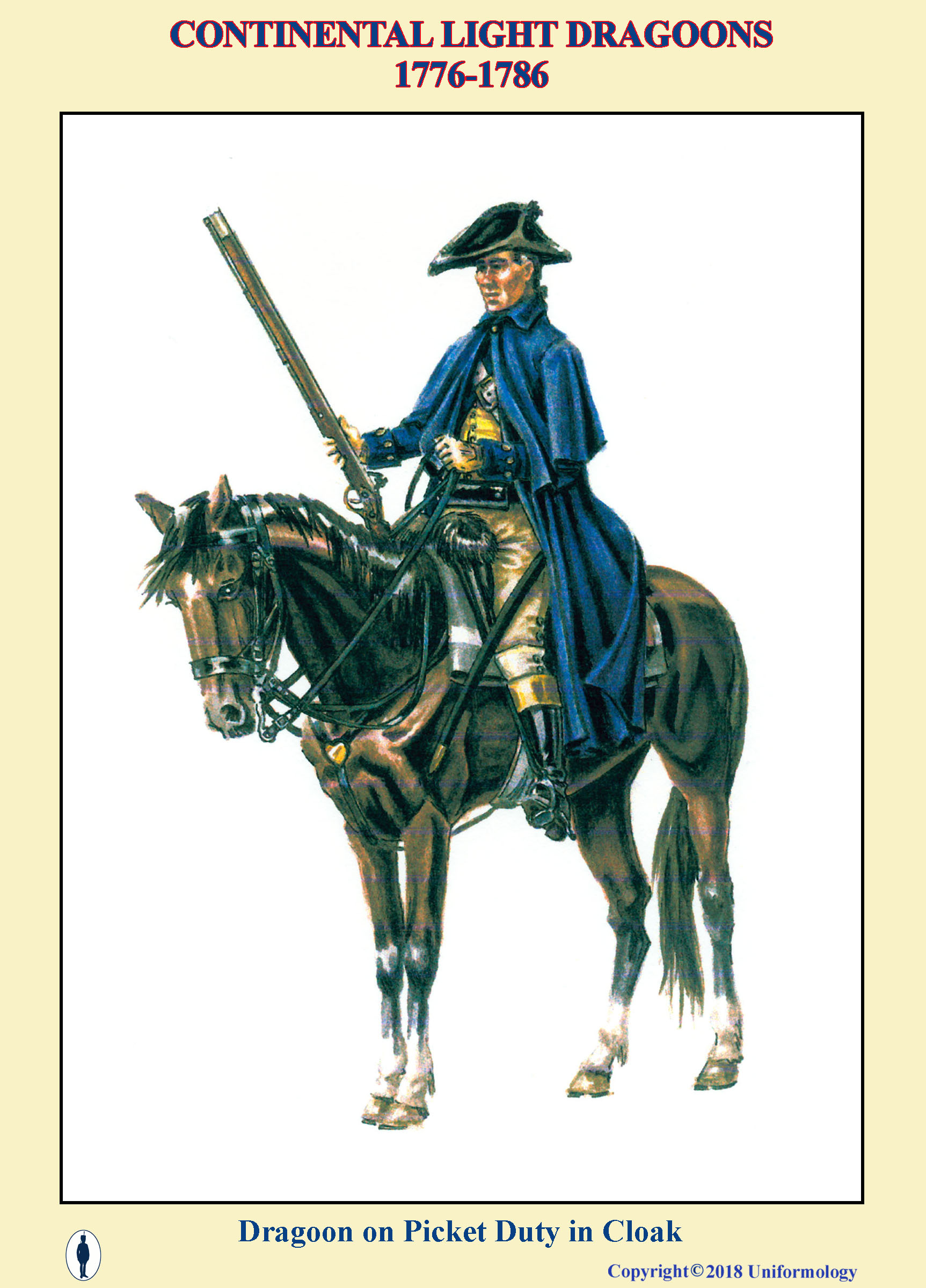CONTINENTAL LIGHT DRAGOONS IN
THE AMERICAN REVOLUTION
From the book by Philip Cranz published by Uniformology in 2008
THE WORLD OF MILITARY UNIFORMS
1660-1914
CONTINENTAL LIGHT DRAGOONS
1776-1786
Illustrations by By Stephen Palatka
Page 1
INTRODUCTION
When it comes to the study of the uniforms of the Continental Army of the Revolution one has very little to go by. The infant nation did not have the kind of record keeping infrastructure that was common in Europe. Supplies, especially finished cloth was hard to come by and much had to come from France or Spain through the British blockade. There was no repository for actual uniforms nor were there a great many actual regulations published. Many soldiers wore their old militia uniforms or even more common civilian clothing with only their cartridge boxes and equipment to mark them as soldiers. The cavalry of George Washington was one of the smallest portions of the military arm. For everything we cannot document about the largest arm, the infantry we know even less about the cavalry. There were officially only four regiments of Continental Light Dragoons and they seldom if ever reached their full strength. The late American historian and artist Randy Steffan in his multi volume work, THE HORSE SOLDIER, about the American cavalry writes about his work on the Continental Army:
".....I choose to treat this chapter on the Continental Dragoons as less than documentary in its descriptions and illustrations. I have used the material Available to me as evidence that points toward the conclusions I have drawn as to what the uniforms, arms, and equipment looked like, and as to how they were used."
The artist, Steven Palatka , a student of history and cavalry has drawn his own conclusions in creating the art for this series. He has combined knowledge of cavalry, equipment and uniforms from the 18th and 19th Centuries along with diligent research into the subject to offer a new interpretation of the Continental Cavalry. Included in his work are not only the four regiments of Light Dragoons but many of the smaller militia units as well.
A note on hair styles: Steffan discusses at length the regulations for hair styles. Owing to the lack of funds this was one of the few aspects of uniformity that could be enforced without expense. Steffan writes:
"Officers were required to powder their hair for guard duty and ceremonies. In garrison the men were required to powder their hair every day and shave at least three times a week. Before a genera l inspection all arms were required to issue two pounds of flour and one-half pound of tallow per one hundred men- for powdering and dressing their hair. Moustaches and beards were forbidden for officers and men in all corps. No other pictorial evidence exists to show facial hair, other than several day old beards on men serving in the Continental Army."
THE CONTINENTAL ARMY
The army formed to fight for independence from Britain was a conglomeration of militias and raw volunteers. Many of the militias close to the untamed frontiers were experienced in fighting indians while those of the more populous areas were little more than social clubs and parade organizations. Uniforms were as varied as the organizations and more dependent on the pocketbooks of the members than a reflection of their fighting prowess. It was not uncommon that the uniform of an officer of one of one militia would be less gaudy than that of a private in one of the wealthier organizations. The only thing that they all have in common is a paucity of records and descriptions.
When the congress formed and army and gave George Washington the title of commander in chief he was faced with not only the challenge of defeating the British and their allies but doing it with an army built from scratch. He knew that to achieve the kind of respectable victory needed to form a new nation he would have to win with a real army in real battles. The kind that were fought in Europe.
With the help of the famous Baron von Steuben and other foreign volunteers with real experience the job was done.
Baltimore Light Horse
The Baltimore troop of light dragoons was part of the Maryland Volunteer Militia. The information from this plate is drawn from a similar plate issued by the Company of Military Historians. The uniforms of this militia regiment are in stark contrast to the previous plate of the Philadelphia Light Horse.
The troopers wore a gray jacket faced with blue without lapels.. The cap similar to that of the British 17th Light Dragoons has a turned up peak ornamented with a stylized “LH” for light horse. The black cap was further ornamented with a blue cloth turban striped with white. The trumpeter is shown in reversed colors and carries a hunting horn rather than a more traditional trumpet. Fox hunting was a popular sport among the wealthy who would no doubt have made up the officers and troopers of the light horse and no doubt the hunting horn was easier to obtain than a military trumpet.
Notice that the mounted soldier rides a very simple saddle without a formal saddle cloth and his holsters are not ornamented. Like many of the other mounted formations it is doubtful that carbines were carried as they were almost always in short supply.
Philadelphia Light Horse
The troop of Philadelphia Light Horse was formed in November 1774 by a group of prosperous gentlemen of the city of Philadelphia shortly after the formation of the First Continental Congress. The troops were a volunteer militia and never a formation of the Continental Army although they served throughout the war. The members were all men of means and supplied their own horses, tack, uniforms and arms.
The uniform consisted of a long “rust brown” jacket with white facings and and brass buttons. The trumpeter was probably uniformed according to the custom of the time in reversed colors with a white jacket with brown facings. The cap was of black leather with a silver cord around the bottom and topped with a “bucks tail”.
Unlike many of the regular army units and most of the other militia units we can surmise because of the wealth of the officers and troopers of the unit that they were well equipped and armed with the best weapons available.
The saddle cloths were of brown cloth with white trim and the saddle holsters were likewise ornamented.
The standard carried during the war was presented to the troop by the first captain of the unit Abraham Markoe. Captain Markoe was chosen as the first captain because of his previous service in the army of Denmark. King Christian II of Denmark issued an edict that all Danish citizens were not allowed to participate in any foreign wars and because Markoe was a Danish citizen he could not participate in the war and had to be replaced.
First Continental Dragoons
The First Continental Dragoons were formed by the government of Virginia from throughout the state in 1775 under the command of Colonel Theodorick Bland. Later that year they were mustered into the Continental Army. There were six troops. We are really not sure what troops wore what uniforms and when.
This plate shows one of the uniforms described in contemporary writings. The jacket is of a light brown with green facings. The caps are of plain black leather. with a green cloth turban. The saddle cloths show in this plate are of dark green trimmed with the light yellow brown of the jackets. It is more likely that gray saddle blankets of different shades were more common.
First Light Dragoons
This is the uniform everyone thinks of when one thinks of the Continental Dragoons. Dark blue jackets with red facings and brass or black leather helmets with white falling horsehair crests. Leffert’s shows this as the uniform of Bland’s own first troop. The light dragoon in the foreground is uniformed and armed in the ideal manner. He holds a British musketoon and his saddle is outfitted with a black leather boot for the musket barrel. The pistol holsters have black bearskin covers.
Second Light Dragoons
The Second Regiment of Continental Dragoons was one of the more storied units. They served mostly in Southern Connecticut and New York. The first commander was Elisha Sheldon and they were sometimes referred to as Sheldon’s Dragoons. They were trained by Major Benjamin Tallmadge who was a celebrated spy for General Washington.
The unit was uniformed in dark blue jackets with buff facings. There helmets were of brass with a dark blue cloth turban and a white falling horsehair crest.
Third Light Dragoons 1781
This plate depicts the more familiar uniform of Baylor’s dragoons. Based in part on a painting of Colonel Baylor the men wear white jackets faced with blue in the style of French dragoons. The black leather belts were particular to this regiment. Sadly on the day these uniforms were issued Colonel Baylor and a large portion of the regiment were ambushed and of 104 privates 67 were killed, wounded or taken captive by British troops under Brigadier General Grey at Old Tappan on the Hackensack River. Baylor was wounded and taken prisoner. The command of the regiment was given to George Washington’s cousin Lt. Col. William Washington and the remainder of the war they fought as Washington’s Legion. It should be noted that in Continental terms when a cavalry unit became a “legion” it ment that they had both mounted and dismounted troops and were capable of serving as a more or less independent command.
Third Light Dragoons 1780
The 3rd Light Dragoons or Baylor’s dragoons were also known as Lady Washington’s dragoons. This plate is historical speculation by the artist based on an auditor’s report showing an issue of a quantity of green cloth to the regiment. Known to have worn white uniforms it is his idea that the green cloth was used for facings and a trumpeter’s uniform. He further shows the trooper to be armed with a carbine though it is doubtful that they had them.
The Fourth Regiment of Light Dragoons
This regiment was recruited mostly from Pennsylvania and was under the command of Colonel Stephen Moylan. According to many reports this unit was kept in first rate shape with good uniforms and equipment according to A. G. Brackett:
……a French gentleman who was travelling through the states during that war, pronounces Moylan as a finished gentleman and his dragoons as fine mounted troops as he had ever seen - and this gentleman had seen most of of the armies of Europe.
The plate depicts the regiment as it appeared after its formation in 1777. They orginally wore scarlet faced in dark blue jackets captured from the British army at Saratoga. To avoid confusion with the enemy Washington ordered that they wear the popular linen hunting shirts as seen on the figure at far right. Due to the effects of wear and weather their colors varied.
The Fourth Light Dragoons 1780
After 1780 the Fourth regiment were issued dark green jackets faced with red- perhaps from France? Leffert’s illustration of this uniform looks very much like a French dragoon of the period.
Dragoons Serving as Infantry
This plate shows troopers of the four regiments of dragoons in uniforms for dismounted service. This is probably the best reconstruction as to how they might have appeared wearing a combination of regular uniforms and personal affectations and civilian dress. Figure 1 illustrates an enlisted man of the 4th dragoon wears his uniform jacket with the addition of an infantryman’s pack. For comfort he has slung his sword belt, normally worn around the waist over his shoulder. He also carries as the rest of the troops in this illustration a full sized infantry musket. Figure 2 has replaced his helmet (If he ever had one.) with a broad brimmed civilian hat. He has ornamented it with a sprig of oak leaves, a common affectation by Continental troops. He wears a tanned leather hunting shirt, probably elk hide, and non- blue cloth trousers. His tomahawk and hunting knife complete his armament. Nothing other than his arms really identifies him as a soldier. Figure 3 is a member of the 3rd dragoon regiment in the white uniform with the speculative green facings. His long trousers with built in gaiters were not worn until late in the war. Figure 4 is a member of the 2nd Dragoons. He has unfastened the turban from his helmet to shade his neck. He has an infantryman’s pack. His sword bayonet combination looks to be of French manufacture. This regiment was especially active along the northeast coast. They are know to have boarded longboats and captured at least one British ship while it was moored.
Officers of Light Dragoons
We have little information on the dress of officers of the Continental Light Dragoons. As all the officers were recognized as members of the "upper crust" of society and no doubt had substantial funds to purchase their own uniforms and acoutrements there is no doubt that they maintained an appearance above that of the troopers. Epaulettes were made of twisted silver cords and the artist has shown all the officers here with crimson sashes as would have been worn by their British counterparts. Contemporary paintings show the officers in well turned out uniforms with small epaulets.
Various Dragoon Regiments & Militia Cavalry
These two plates illustrate eight different regiments or corps. The word “regiment” should be considered very loosely for many of these troops of mounted soldiers might consist of as few as thirty or forty men and never much over one hundred. Six of these units served in the Southern campaign. All of these with the exception of Lee’s Legion were part of the corps of Lt Colonel Francis Marion, later Brigadier General of the South Carolina Militia. Who fought against Banastre Tarleton.
Fig. 1 Horry’s Regiment 1782 - part of the command of Francis Marion and members of the South Carolina Militia.
Fig. 2 Connecticut Light Horse - This small group of Connecticut served mainly in the north and wore a number of different uniforms. Like many of the other mounted troops they were made up of the wealthier members of society.
Fig. 3 Myddleton’s Regiment - part of the command of Francis Marion and members of the South Carolina Militia.
Fig. 4 Lee’s Legion- Under the command of the famous Col. Henry (”Light Horse Harry”) Lee, father of the famous Confederate General Robert E. Lee, this was perhaps the most famous of all the Continental cavalry formations. It was originally the Fifth Troop of the First Regiment of Continental Light Dragoons consisting of thirty troopers. Later it was detached as Lee’s Legion and consisted of both mounted troopers and infantry. After meritorious service in the Northern theater of the war it was later transfered to the South and served in conjunction with the troops under the famous Francis Marion fighting Cornwallis and Banastre Tarleton.
Fig. 5 Hammond’s Legion - part of the command of Francis Marion and members of the South Carolina Militia. Perhaps Hampton’s Legion.
Fig. 6 Horry’s Regt 1779- - part of the command of Francis Marion and members of the South Carolina Militia.
Fig. 7 Maham’s Regiment - part of the command of Francis Marion and members of the South Carolina Militia.
Fig. 8 von Heer’s Provost Corps- von Heer’s provosts were the military police of the army and attached to Washington’s headquarters. They were charged with apprehending deserters and looters and carrying out the punishments of soldiers convicted by court martial. One or two of the troops were paid as executioners. Their uniform was in the light dragoon style as illustrated with dark blue coats with yellow/orange facings. Their uniforms were probably well maintained and in good repair owing to their proximity to the army’s headquarters.
Figures 1,3,5.6. and 7 represent mounted troops of the South Carolina Militia. Probably few of these uniforms existed except for a few officers and non-coms in troops of no more than forty men. No uniform regulations exist and few actual articles have survived. Our artist has reconstructed these from a few meager contemporary descriptions and some plates from the Company of Military Historians.
Dragoon on Picket Duty
This plate illustrates a trooper of the 1st Light Dragoons on picket duty after 1780. According to Stefan, in 1780 new uniforms were issued to the regi ment from stores of cloth in Virginia and the coats were of black or very dark blue with green facings. This trooper wears a bicorne hat of type worn by the French which was somewhat flatter than the British tricornne illustrated in the previous plate. The artist has given this trooper a civilian Kentucky or Pennsylvania style rifle rather than a musket or carbine.
NEXT
WEAPONS AND EQUIPMENT
OF THE CONTINENTAL DRAGOONS


